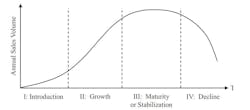This article was updated Nov. 17, 2022. It was originally published July 6, 2018.
RELATED
Why Cloud PLM Is Taking Manufacturing by Storm
How Does One Get Started with PLM and the Digital Twin?
What’s the Difference Between PLM, CPQ and Product Planning Software?
Manufacturers need to know what they are doing in terms of product development and why they are doing it. It’s too important to leave to chance or intuition. That means managers and the design team need to determine what the company will be making and then ask the right questions regarding this new product’s lifecycle.
A product’s lifecycle usually roughly follows the shape of a bell curve and has four stages: development, rapid growth, sales stabilize or slow, and finally sales decline.
Many companies use product lifecycle management (PLM) to predict the shape of this bell curve and use that prediction for marketing and sales. But to fully understand what will happen in a product’s lifecycle, designers and management must continue to ask questions after the product has been designed and put on the market.
Not every lifecycle stage calls for the same type of questions. In the first stage, for example, companies need to know the product’s value and its perfect audience or end-users. Once much further into the product’s lifecycle, questions should center on product improvement and quality control.
Here are some of the important questions that should be asked in each stage.
Stage 1: Introduction
Initially, everyone involved must understand what PLM is and how it can help the business. That’s why these first questions are specific to the PLM process rather a particular product.
- How are the PLM’s objectives aligned to the company’s overall stakeholder strategy?
- What do we need to know about PLM?
During this phase, also strive to understand the customers for your product, as well as the pain or frustrations your product will eliminate or minimize.
Last, but not least, establish some boundaries. What will you not make? Where and when do you stop designing? Setting clear boundaries on the product can save time and money.
Designers could start with a minimally viable product and then ask potential customers for feedback in stage two. If a company decides to make upgrades based on this feedback, it should ensure its turnaround times are short and improvements are done often. That way, the ongoing changes in the product will not lower the endusers’ perception of the product’s quality.
- Are customers identified and segmented according to their different needs and requirements?
- Is there a description of the suppliers, inputs, process, outputs and customers?
- What are the product’s boundaries for features and functions? When do we stop developing this product?
Stage 2: Growth
With the product on the market and sales numbers coming in, results can be measured. The trick is identifying what can be measured but shouldn’t be. You need to determine the most obvious and appropriate measurements for your products.
What gets measured gets managed, so don’t brush over this step. Make sure you answer the question diligently, and that you have the capabilities and resources to measure the things that help increase sales and grow the business.
READ MORE: How PLM Advances Digital Integration
Some example questions about measuring and analyzing:
- What measurements are being captured?
- What is the total cost in relation to deploying the product using PLM, including any consulting or professional services?
- What are the levels and trends in key measures or indicators of product and process performance important to your customers?
Stage 3: Maturity
At this point, the market knows the product and management can predict sales numbers based on several years of reliable data. The most important goal now is to keep the sales growing.
Management needs to ask about the product’s validity in a changing market. Does the product need to be improved or should the marketing message change? Has a new audience emerged for the same product that can be tapped?
Example questions to ask are:
- What resources are needed for improvement efforts?
- What must improve and by how much?
- Risk management: What could go wrong?
Stage 4: Decline
Eventually there comes a time when sales start slowing down despite the company trying every product-extension trick in the book, including adding more advertising, lowering prices and providing add-on products.
If a company wants to continue selling this product, it needs to ask the really hard questions about its profitability and how to control the environment in which the product is made and sold.
There will also come a time when the company should take the product off the market and focus on new products or new markets.
Example questions to ask during this phase are:
- Is there a standardized process that could lower costs?
- What can you control?
- What’s the craziest thing we can do?
While PLM and all of this might look like a linear process on paper, these stages happen at different speeds for different products. For each product, engineers and managers need to ask different questions. This helps identify where each product sits in its lifecycle and how to manage the company’s entire portfolio of products. There can also be overlap between products at different stages. For example, while identifying customers a new product, an older product may be moving into the last phase of declining sales. So, can the company fulfill a need in the customers of the older product with the newer one?
To get the most out of the answers to all the questions asked during the products lifecycle it’s critical that they be documented. Every decision needs to be recorded so that it can be cross-referenced later. Only when every product team creates these records can the team and others in the company learn from each other and improve product lifecycle with every new product design.
Ivanka Menken is an entrepreneur and owner and co-founder of The Art of Service. She also wrote the book Product Lifecycle Management Self-Assessment Guide .

